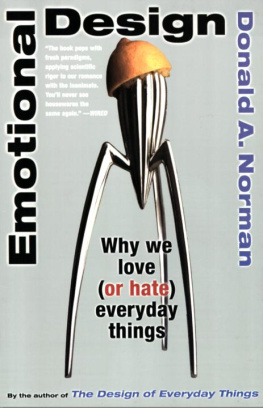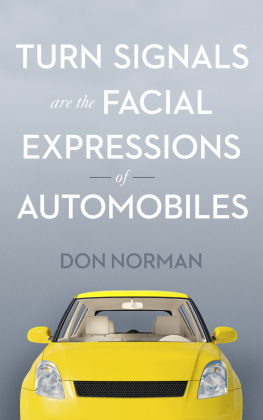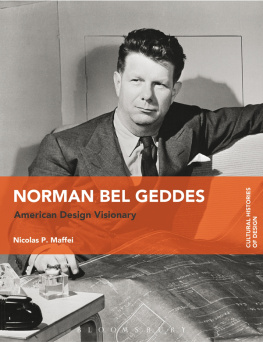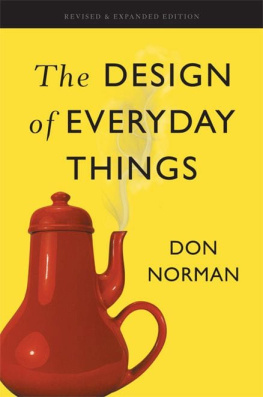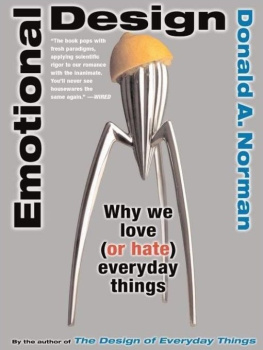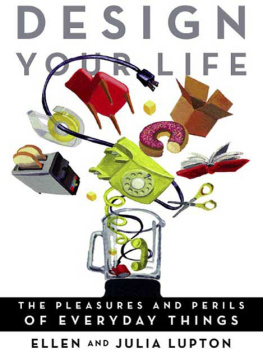Donald A. Norman - The Design of Everyday Things
Here you can read online Donald A. Norman - The Design of Everyday Things full text of the book (entire story) in english for free. Download pdf and epub, get meaning, cover and reviews about this ebook. year: 2013, publisher: Basic Books, genre: Romance novel. Description of the work, (preface) as well as reviews are available. Best literature library LitArk.com created for fans of good reading and offers a wide selection of genres:
Romance novel
Science fiction
Adventure
Detective
Science
History
Home and family
Prose
Art
Politics
Computer
Non-fiction
Religion
Business
Children
Humor
Choose a favorite category and find really read worthwhile books. Enjoy immersion in the world of imagination, feel the emotions of the characters or learn something new for yourself, make an fascinating discovery.

- Book:The Design of Everyday Things
- Author:
- Publisher:Basic Books
- Genre:
- Year:2013
- Rating:5 / 5
- Favourites:Add to favourites
- Your mark:
- 100
- 1
- 2
- 3
- 4
- 5
The Design of Everyday Things: summary, description and annotation
We offer to read an annotation, description, summary or preface (depends on what the author of the book "The Design of Everyday Things" wrote himself). If you haven't found the necessary information about the book — write in the comments, we will try to find it.
The Design of Everyday Things — read online for free the complete book (whole text) full work
Below is the text of the book, divided by pages. System saving the place of the last page read, allows you to conveniently read the book "The Design of Everyday Things" online for free, without having to search again every time where you left off. Put a bookmark, and you can go to the page where you finished reading at any time.
Font size:
Interval:
Bookmark:
THE
DESIGN
OF EVERYDAY
THINGS
ALSO BY
DON NORMAN
TEXTBOOKS
Memory and Attention: An Introduction to
Human Information Processing.
First edition, 1969; second edition 1976
Human Information Processing.
(with Peter Lindsay: first edition, 1972; second edition 1977)
SCIENTIFIC MONOGRAPHS
Models of Human Memory
(edited, 1970)
Explorations in Cognition
(with David E. Rumelhart and the LNR Research Group, 1975)
Perspectives on Cognitive Science
(edited, 1981)
User Centered System Design: New Perspectives on Human-Computer Interaction
(edited with Steve Draper, 1986)
TRADE BOOKS
Learning and Memory, 1982
The Psychology of Everyday Things, 1988
The Design of Everyday Things
1990 and 2002 (paperbacks of The Psychology of Everyday Things with new prefaces)
The Design of Everyday Things
Revised and Expanded Edition, 2013
Turn Signals Are the Facial Expressions of Automobiles, 1992
Things That Make Us Smart, 1993
The Invisible Computer: Why Good Products Can Fail, the Personal Computer Is So Complex, and Information Appliances Are the Answer, 1998
Emotional Design: Why We Love (or Hate) Everyday Things, 2004
The Design of Future Things, 2007
A Comprehensive Strategy for Better Reading: Cognition and Emotion, 2010
(with Masanori Okimoto; my essays, with commentary in Japanese, used for teaching English as a second language to Japanese speakers)
Living with Complexity, 2011
CD-ROM
First person: Donald A. Norman. Defending Human Attributes in the Age of the Machine, 1994
THE
DESIGN
OF EVERYDAY
THINGS
REVISED AND EXPANDED EDITION
Don Norman
BASIC BOOKS
A Member of the Perseus Books Group
New York
Copyright 2013 by Don Norman
Published by Basic Books,
A Member of the Perseus Books Group
All rights reserved. No part of this book may be reproduced in any manner whatsoever without written permission except in the case of brief quotations embodied in critical articles and reviews. For information, address Basic Books, 250 West 57th Street, 15th Floor, New York, New York 10107.
Books published by Basic Books are available at special discounts for bulk purchases in the United States by corporations, institutions, and other organizations. For more information, please contact the Special Markets Department at the Perseus Books Group, 2300 Chestnut Street, Suite 200, Philadelphia, PA 19103, or call (800) 810-4145, ext. 5000, or e-mail .
Library of Congress Cataloging-in-Publication Data
Norman, Donald A.
[Psychology of everyday things]
The design of everyday things / Don Norman.Revised and expanded edition.
pages cm
ISBN 978-0-465-07299-6 (ebook) 1. Industrial designPsychological aspects. 2. Human engineering. I. Title.
TS171.4.N672013
745.2001'9dc23
2013024417
10 9 8 7 6 5 4 3 2 1
For Julie
CONTENTS
In the first edition of this book, then called POET, The Psychology of Everyday Things, I started with these lines: This is the book I always wanted to write, except I didnt know it. Today I do know it, so I simply say, This is the book I always wanted to write.
This is a starter kit for good design. It is intended to be enjoyable and informative for everyone: everyday people, technical people, designers, and nondesigners. One goal is to turn readers into great observers of the absurd, of the poor design that gives rise to so many of the problems of modern life, especially of modern technology. It will also turn them into observers of the good, of the ways in which thoughtful designers have worked to make our lives easier and smoother. Good design is actually a lot harder to notice than poor design, in part because good designs fit our needs so well that the design is invisible, serving us without drawing attention to itself. Bad design, on the other hand, screams out its inadequacies, making itself very noticeable.
Along the way I lay out the fundamental principles required to eliminate problems, to turn our everyday stuff into enjoyable products that provide pleasure and satisfaction. The combination of good observation skills and good design principles is a powerful tool, one that everyone can use, even people who are not professional designers. Why? Because we are all designers in the sense that all of us deliberately design our lives, our rooms, and the way we do things. We can also design workarounds, ways of overcoming the flaws of existing devices. So, one purpose of this book is to give back your control over the products in your life: to know how to select usable and understandable ones, to know how to fix those that arent so usable or understandable.
The first edition of the book has lived a long and healthy life. Its name was quickly changed to Design of Everyday Things (DOET) to make the title less cute and more descriptive. DOET has been read by the general public and by designers. It has been assigned in courses and handed out as required readings in many companies. Now, more than twenty years after its release, the book is still popular. I am delighted by the response and by the number of people who correspond with me about it, who send me further examples of thoughtless, inane design, plus occasional examples of superb design. Many readers have told me that it has changed their lives, making them more sensitive to the problems of life and to the needs of people. Some changed their careers and became designers because of the book. The response has been amazing.
Why a Revised Edition?
In the twenty-five years that have passed since the first edition of the book, technology has undergone massive change. Neither cell phones nor the Internet were in widespread usage when I wrote the book. Home networks were unheard of. Moores law proclaims that the power of computer processors doubles roughly every two years. This means that todays computers are five thousand times more powerful than the ones available when the book was first written.
Although the fundamental design principles of The Design of Everyday Things are still as true and as important as when the first edition was written, the examples were badly out of date. What is a slide projector? students ask. Even if nothing else was to be changed, the examples had to be updated.
The principles of effective design also had to be brought up to date. Human-centered design (HCD) has emerged since the first edition, partially inspired by that book. This current edition has an entire chapter devoted to the HCD process of product development. The first edition of the book focused upon making products understandable and usable. The total experience of a product covers much more than its usability: aesthetics, pleasure, and fun play critically important roles. There was no discussion of pleasure, enjoyment, or emotion. Emotion is so important that I wrote an entire book, Emotional Design, about the role it plays in design. These issues are also now included in this edition.
My experiences in industry have taught me about the complexities of the real world, how cost and schedules are critical, the need to pay attention to competition, and the importance of multidisciplinary teams. I learned that the successful product has to appeal to customers, and the criteria they use to determine what to purchase may have surprisingly little overlap with the aspects that are important during usage. The best products do not always succeed. Brilliant new technologies might take decades to become accepted. To understand products, it is not enough to understand design or technology: it is critical to understand business.
Next pageFont size:
Interval:
Bookmark:
Similar books «The Design of Everyday Things»
Look at similar books to The Design of Everyday Things. We have selected literature similar in name and meaning in the hope of providing readers with more options to find new, interesting, not yet read works.
Discussion, reviews of the book The Design of Everyday Things and just readers' own opinions. Leave your comments, write what you think about the work, its meaning or the main characters. Specify what exactly you liked and what you didn't like, and why you think so.

